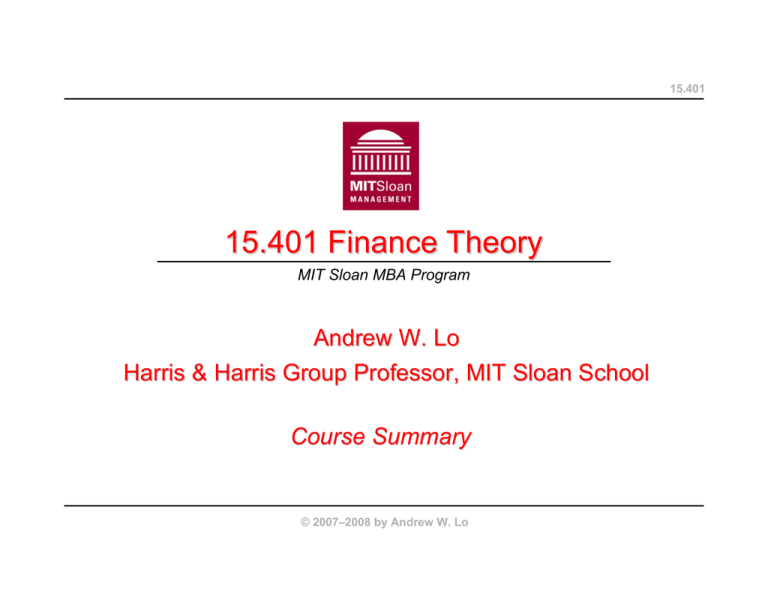15.401 Finance Theory Andrew W. Lo Course Summary
advertisement

15.401 15.401 Finance Theory MIT Sloan MBA Program Andrew W. Lo Harris & Harris Group Professor, MIT Sloan School Course Summary © 2007–2008 by Andrew W. Lo Motivation 15.401 Mathematics + $$$ = Finance Photographs removed due to copyright restrictions. James Simons Renaissance Technologies Course Summary Jack Welch General Electric © 2007–2008 by Andrew W. Lo Warren Buffett Berkshire Hathaway Slide 2 Dramatis Personae 15.401 A Flow Model of the Economy Households Labor Product Markets Markets Financial Intermediaries Capital Markets Nonfinancial Corporations The Financial System Course Summary © 2007–2008 by Andrew W. Lo Slide 3 Six Fundamental Principles of Finance 15.401 P1: There Is No Such Thing As A Free Lunch P2: Other Things Equal, Individuals : Prefer more money to less (non-satiation) Prefer money now to later (impatience) Prefer to avoid risk (risk aversion) P3: All Agents Act To Further Their Own Self-Interest P4: Financial Market Prices Shift to Equalize Supply and Demand P5: Financial Markets Are Highly Adaptive and Competitive P6: Risk-Sharing and Frictions Are Central to Financial Innovation Course Summary © 2007–2008 by Andrew W. Lo Slide 4 Course Overview 15.401 Four Sections A. Introduction Fundamental challenges of finance A framework for financial analysis Six principles of finance Cashflows and the time-value of money B. Valuation Discounting and the mathematics of net present value Pricing stocks, bonds, futures, forwards, and options C. Risk Measuring risk Managing risk (portfolio theory) Incorporating risk into valuation methods Course Summary © 2007–2008 by Andrew W. Lo Slide 5 Course Overview 15.401 Four Sections D. Corporate Finance Capital budgeting and project finance Final Lecture: Market Efficiency (putting it all together) Do financial markets always work well in discovering prices? What about behavioral biases and human psychology? How should finance theory be used in practice? Course Summary © 2007–2008 by Andrew W. Lo Slide 6 Key Points: Present Value 15.401 Assets are sequences of cash flows Date-t cashflows are different from date-(t+k) cashflows Use "exchange rates" to convert one type of cashflow into another PV and FV related by "exchange rates" Exchange rates are determined by supply/demand Opportunity cost of capital: expected return on equivalent investments in financial markets For NPV calculations, visualize cashflows first Decision rule: accept positive NPV projects, reject negative ones Special cashflows: perpetuities and annuities Compounding Inflation Extensions and Qualifications Course Summary © 2007–2008 by Andrew W. Lo Slide 7 Key Points: Fixed-Income Securities 15.401 Valuation of riskless pure discount bonds using NPV tools Coupon bonds can be priced from discount bonds via arbitrage Current bond prices contain information about future interest rates Spot rates, forward rates, yield-to-maturity, yield curve Interest-rate risk can be measured by duration and convexity Corporate bonds contain other sources of risk Course Summary © 2007–2008 by Andrew W. Lo Slide 8 Key Points: Equity Securities 15.401 The Dividend Discount Model The Gordon Growth Model Discount rate, cost of capital, required rate of return Estimating discount rates with D/P and g EPS, P/E, and PVGO Definitions of growth stocks and growth opportunities Course Summary © 2007–2008 by Andrew W. Lo Slide 9 Key Points: Futures and Forwards 15.401 Forward and futures contracts are zero-NPV contracts when initiated After initiation, both contracts may have positive/negative NPV Futures contracts are “marked to market” every day Futures and forwards are extremely liquid Hedging and speculating are important applications of futures/forwards Course Summary © 2007–2008 by Andrew W. Lo Slide 10 Key Points: Options and Other Derivatives 15.401 Options have nonlinear payoffs, as diagrams show Some options can be viewed as insurance contracts Option strategies allow investors to take more sophisticated bets Valuation is typically derived via arbitrage arguments (e.g., binomial) Option-pricing models have a long and illustrious history Course Summary © 2007–2008 by Andrew W. Lo Slide 11 Key Points: Introduction to Risk and Return 15.401 Anomalies: Size Effect: Smaller stocks typically outperform larger stocks, especially in January. January Effect: Returns in January tend to be abnormally high. Value Effect: Low P/B (value) stocks typically outperform high P/B (growth) stocks. Momentum: Stocks with high returns over the past 12 months typically continue to outperform stocks with low past returns. Accruals and Issuances: Stocks with high past accruals and/or recent stock offerings typically underperform stocks with low past accruals and no stock offerings. Course Summary © 2007–2008 by Andrew W. Lo Slide 12 Key Points: Portfolio Theory 15.401 'LYHUVLILFDWLRQUHGXFHVULVN The standard deviation of a portfolio is always less than the average standard deviation of the individual stocks in the portfolio. ,QGLYHUVLILHGSRUWIROLRVFRYDULDQFHVDPRQJVWRFNVDUHPRUH LPSRUWDQWWKDQLQGLYLGXDOYDULDQFHV 2nly systematic risk matters. ,QYHVWRUVVKRXOGWU\WRKROGSRUWIROLRVRQWKHHIILFLHQWIURQWLHU These portfolios maximize expected return for a given level of risk. :LWKDULVNOHVVDVVHWDOOLQYHVWRUVVKRXOGKROGWKHWDQJHQF\ SRUWIROLR 7KLVportfolio maximizes the trade-off between risk and expected return. Course Summary © 2007–2008 by Andrew W. Lo Slide 13 Key Points: The CAPM 15.401 Tangency portfolio is the market portfolio This yields the capital market line (efficient portfolios) The CAPM generalizes this relationship for any security or portfolio: The security market line yields a measure of risk: beta This provides a method for estimating a firm’s cost of capital The CAPM also provides a method for evaluating portfolio managers – Alpha is the correct measure of performance, not total return – Alpha takes into account the differences in risk among managers Empirical research is mixed, but the framework is very useful Course Summary © 2007–2008 by Andrew W. Lo Slide 14 Key Points: Capital Budgeting 15.401 Use the NPV rule for capital budgeting decisions: take all projects with positive NPV, or take highest-NPV project if mutually exclusive Consider project interactions separately Use after-tax cashflows for NPV calculations, not accounting earnings Use the CAPM to estimate cost of capital with project beta Be careful about risks that change over time or across different stages Be wary of alternative to NPV: – Payback rule, discounted payback rule – Profitability index – Internal rate of return Course Summary © 2007–2008 by Andrew W. Lo Slide 15 Key Points: Market Efficiency 15.401 Several types of market microstructure Markets have several functions Markets work well most of the time Price discovery process is not costless nor effortless Convergence of market prices to rational expectations equilibria Bubbles, crashes, excess volatility, are part of normal markets Emotional state of the market matters The Adaptive Markets Hypothesis integrates rational and behavioral Course Summary © 2007–2008 by Andrew W. Lo Slide 16




